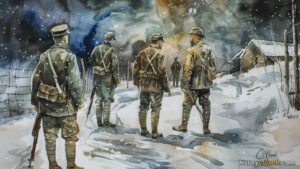Rome in the Renaissance was one of the largest and most significant city-states during the Renaissance. Rome played a central role in the Renaissance, especially during the 15th and 16th centuries when it became a hub for art, architecture, and religion. Under the patronage of powerful popes like Martin V and Pope Eugene IV, influential Renaissance artists transformed the city with masterpieces such as the Sistine Chapel and St. Peter’s Basilica.
WHAT WAS THE RENAISSANCE?
The Renaissance is an important event in European history that stretched from the 14th century to the 17th century. It was preceded by the Middle Ages in Europe and eventually led to other major events such as the Age of Enlightenment. In historical terms the Renaissance is important because it led to a major shift in European thought and worldview. The Renaissance is considered to have begun in the city-states of the Italian peninsula, such as: Genoa, Florence, Milan, Naples, Rome and Venice.
In each of these city-states, the significant changes of the overall Renaissance occurred and unfolded. For example, the most significant changes that emerged as a result of the Renaissance can be seen in European architecture, art, literature, mathematics, music, philosophy, politics, religion and science. Intellectual thought in these fields flourished during the timeframe of the Renaissance and led to many people questioning long held beliefs about each. This created an environment of discovery and curiosity in which new ideas were constantly being introduced and tested. As well, European life before the start of the Renaissance was dominated by feudalism and the Manor System, but these both played small roles for citizens in the powerful Italian city-states. As such, the major Italian city-states listed above were well positioned to undergo the societal shift brought about by the new Renaissance ideas.
ROME BEFORE THE RENAISSANCE
Rome (also referred to as the ‘Eternal City’) is one of the most significant city-states from the Renaissance in Italy and developed in the central region of the Italian peninsula. The city of Rome is located on the Tiber River. The area was comprised of a series of hills and early settlements began on these hills. Historians have determined that human beings have been living in the area around Rome since about 14,000 years ago. Regardless, the city has been an important site throughout its history, including: ancient history, Middle Ages, Renaissance and modern times. For example, today the city is considered to be one of the finest in the entire world and contains many ancient ruins from its storied past.
In terms of its ancient history, the city of Rome was originally said to have been settled in the 8th century BCE. In ancient Roman history, the city was said to have been founded by Romulus and Remus. The myth tells that they were twins and established the city together. However, a fight occurred and Romulus killed Remus and then named the city after himself. Regardless, historians agree that the city was likely first settled in 753 BCE.
Throughout the centuries that followed, Rome was ruled by a series of kings and then later an oligarchic republic, meaning it was ruled by a small set of elites. During this time the city quickly grew in importance and population. It furthered gained territory and influence through the Punic Wars against Carthage and Macedonian Wars against Macedonia. What follows is one of the most significant times in its entire history – the Roman Empire.
The great Roman Empire extended from 27 BCE until 395 CE. This was a major height in the history of the city and saw it expand as it was the capital of the entire empire, which extended throughout much of Europe, Northern Africa and the Middle East. Because it was the capital of such a vast empire, the city of Rome prospered with trade with goods from distance places. Also, during this time the city saw the construction of several major projects including the Colosseum. At the time, every Roman town had an amphitheater which was a large stadium in which entertainment and Roman ‘games’ would take place. The largest and most famous Roman amphitheater was the Colosseum in Rome. It is also one of the most famous structures in all of Ancient Rome. It was built between 70 and 80 CE and was ordered to be built by Emperor Vespasian who ruled over Rome from 69 to 79 CE. His family name was ‘Flavian’; therefore the original name of the Colosseum was the Flavian Amphitheater.
After the fall of the Roman Empire, Christianity became increasingly important across Italy and all of Europe. In fact, by the time of the Middle Ages, Christianity was the dominant religion in Europe. The bishop of Rome is referred to as the Pope. Today the Pope lives in the Vatican City, which is a section of Rome that is considered to be an independent state. The Vatican City is important because it houses several important historical sites that are significant to the history of the city of Rome and to the Renaissance, including: the Sistine Chapel and Saint Peter’s Basilica.
ROME IN THE RENAISSANCE – HUMANISM
The Renaissance in the city-state of Rome began in the early 15th century during a time of relative peace. This allowed art and other Renaissance pursuits to flourish in the Italian city-state. In fact, the center of the Italian Renaissance shifted from Florence to Rome throughout this century, as it became a beacon of humanist ideals. One of the main features of the Renaissance was the rediscovery by European thinkers of ancient Greek and Roman ideas and texts. For example, the term ‘renaissance’ in French means ‘rebirth’. This is in relation to the idea that the intellectual culture of the Renaissance was sparked by the rediscovery of these ancient philosophies and ideas which had largely been ignored in Europe throughout the Middle Ages.
In general, Renaissance Humanism was the study of ancient Greek and Roman texts with the goal of promoting new norms and values in society. These norms and views varied from those at the time because they focused less heavily on a religious worldview. Instead, Renaissance humanists such as Petrarch used ancient texts to promote a worldview based on logic and reason. This was to be accomplished through the study of the ‘studia humanitatis’, which today is known as the humanities and includes topics such as: grammar, history, poetry, and philosophy. Renaissance humanists such as Petrarch promoted the idea that citizens should be educated in these topics in order to allow them to participate in the social and political life of their society. This was a fundamental shift from the feudalistic and religious life that was the reality for most people in the Europe in the Middle Ages. Humanist ideals flourished in the city-state of Rome in the 15th and 16th centuries because Renaissance scholars and artists travelled to the city to study its many ancient ruins. This was especially important for Renaissance artists and sculptors of the time as they sought to use different styles and techniques in their own works that were heavily inspired by Ancient Roman art and architecture present in Rome.
ROME IN THE RENAISSANCE – SIGNIFICANT POPES
The Renaissance in Rome unfolded through the leadership of several different Popes throughout the 15th and 16th centuries. For example, Martin V was elected Pope on November 11th, 1417 and finally arrived in the city of Rome in 1420. During his time as Pope, several prominent Renaissance artists became associated with Rome. For instance, Donatello travelled to Rome to study classical art and excavate ruins of ancient Rome. The trip is not well documented, but it is thought that the trip could have helped Donatello develop an understanding of classical sculptures that would help to shape and influence his own art. He supposedly remained in the city-state of Rome until 1433 when he returned to Florence. As well, famous Renaissance artist Masaccio travelled to Rome in 1423, along with his mentor Masolino. Masaccio was heavily influenced by his time in Rome and many historians consider his altarpiece for the Carmelite Church in Pisa as evidence of this. As well, much of his work after the trip appeared to be heavily influenced by ancient Roman and Greek art.
Pope Martin V was replaced following his death in 1431 by Pope Eugene IV. His papacy was a difficult time for Rome, but it still led to several major contributions to the Renaissance. For example, he commissioned Florentine sculptor Antonio Averulino (who was also known as Filarete) to make the two bronze doors of Saint Peter’s Basilica, which he completed in 1445. The six panels show Jesus the Savior and Mary enthroned, St. Paul with the sword, and St. Peter, who is giving the keys to the kneeling Pope Eugene IV.
Pope Eugene IV died in 1447 and was replaced by Pope Nicholas V. He would serve as Pope until 1455. Nicholas V is best remembered for his work with Leon Battista Alberti, who was an Italian architect, author, humanist scholar, and poet. Due to his many talents, historians consider him to be an example of the concept of a Renaissance Man. Together, Nicholas V and Alberti created a plan to build several large projects in Rome including many churches.


